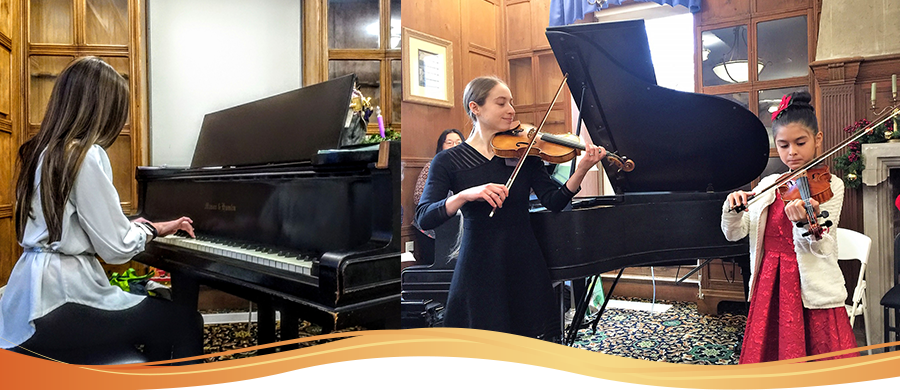
Online
Music for the Community
If you're interested in a particular category, you can sort performances by student age, instrument, singalong music, composer and so on - click on the orange tags under the text. We hope you and your family will enjoy watching our students share their music!
To have each week's videos and accompanying info sent to your inbox*, please subscribe via the orange button.
*Videos are delivered twice weekly; you can unsubscribe at any time, and we will never share or sell your info.
Subscribe to this Page
Day 46 - Hongroise (Hungarian Dance)
Violinist age 9 plays "Hongroise" by Robert Pracht.
Week of June 1st: Lament
To quote Martin Luther King Jr., "Injustice anywhere is a threat to justice everywhere." As members of communities both smaller and larger, what affects some of us affects all of us, and if we stay silent in the face of egregious injustice, we risk becoming become complicit in it.
"Lament", performed by the composer
Day 40: The Boy Paganini
Day 39: Not Jingle Bells; Row, Row, Row your Boat; and......?
Pianist age 6 plays "This is not Jingle Bells" and "Row, Row, Row your Boat"
Day 38: Bourrée 1 & 2 by Bach
Cellist age 16 plays Bourrées I & II from Bach Solo Suite #3 in C
More old-fashioned dance music today, but unlike a Minuet, a Bourrée (pronounced "boo-ray") is in duple time (ONE two, ONE two) – similar to a Gavotte. Still, like our Minuet and Trio on Day 36, this set of two Bourrées is again made on an overall A B A pattern.
Day 37: Red Parrot, Green Parrot
Violinist age 8 plays "Red Parrot, Green Parrot" by Edwards Huws Jones
Day 36: Mozart Minuet and Trio
Violist age 12 plays Minuet & Trio by Mozart
Day 35: Vivaldi Cello Sonata in A minor
Cellist age 15 plays Vivaldi Cello Sonata in A minor
Born in Venice on the day of an earthquake, Italian composer Antonio Vivaldi (1678 -1741) is regarded as one of the greatest composers of the Baroque era, and during his lifetime he was famous across Europe. He composed many instrumental works, especially for string instruments - many of which were written for girls at the orphanage in Venice, whose musical skill improved their marriage prospects at a time when there were few other options for women. He also wrote a large amount of church music, and more than forty operas. His best-known work is the series of violin concertos known as the Four Seasons - we featured "Spring" earlier in this series.
Vivaldi wrote a set of six cello sonatas (works for a solo instrument, usually with accompaniment by a keyboard) between 1720 and 1730. All of them have four alternating slow and fast movements (separate pieces); this is the second movement of the third sonata.
Day 34: The Dance of the Spider and the Fly
Pianist age 8 plays "The Dance of the Spider and the Fly" by Donald Waxman
A native of Baltimore, Donald Waxman met his wife Jho at the Peabody Conservatory, and shortly after graduation the couple founded a music school in Nyack, New York. Like our Day 2 composer, Kabalevsky, the Waxmans felt that musical language in the piano methods of the time was dated, and not challenging or interesting enough for 20th century students.
Mr. Waxman says, “ I wanted young students to be working in a language more varied than that of so many piano method books. I wanted students to be playing and hearing music written in a wide variety of intervals, modes and tonal and chromatic combinations that go beyond the extreme limitations of music based primarily on the triads.” We think you’ll agree that he succeeded!


